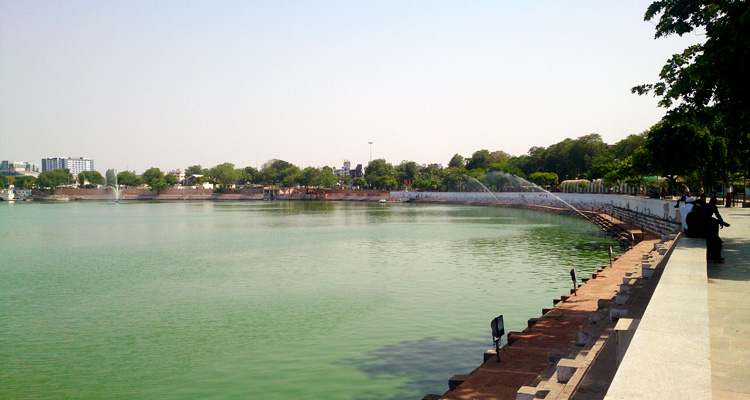Kankaria Lake Front truly represents rejuvenated pedestrianized urban space in East Ahmedabad and offers to its visitor’s a variety of entertainment options for practically people of all age limits. The lake front has been redeveloped by Ahmedabad Municipal Corporation to offer modern urban space with best in class entertainment facilities like tethered balloon safari, train ride, ultra-modern high speed rides, kids specific activity areas like Kids City. KLF offers options to people depending on their interest in terms of following:

Adventure Sports -Tree-walk, Mini Golf, Desert Safari, High-Speed Ski-boats and soon to be launched high speed rides.
The rejuvenated urban space truly represents Ahmedabad city government’s aim to elevate services to international class and transcend into the modern lifestyle.
The historical Kankaria Lake having a periphery of about 2.5 Km has been the symbol of Ahmadabad’s identity for almost 500 years. The historic lake around an island garden called Naginawadi has been an evergreen outing place for the people of Ahmedabad. Along with the adjoining Zoo, Balvatika, Aquarium and surrounding hill gardens, it offered a complete entertainment centre. Given an expanse of around 4 sq. km of permanently filled water body, it has acted as the lungs of the relatively lower income South Eastern part of the city.
Kankaria visited by hundreds of visitors was an urban chaos characterized by unclean ghats, traffic Chaos on the 2.4 miles periphery road, unorganized street life including a congested eating area on one corner thriving with street food vendors. The periphery wall was in a dilapidated state, and lake precincts presented somewhat unclean and disorganized environment. Vehicle parking along the periphery walls often blocked the view, and visiting children had a hard time amidst the noise, traffic and resultant chaos. Kankaria had also gained notoriety as a suicide point. In short, a city level pubic space with high potential for being a high quality recreational/entertainment space had deteriorated.

Given the opportunity, the development of the lakefront was planned with facilities like Mini Train, Food Courts, walkways, Linear Gardens & Landscapes and Musical Fountains by the Ahmedabad Municipal Corporation. AMC adopted a model of service delivery of various recreational activities through in-house planning and capacity building combined with use of capable and experienced private sector players in a phased manner.
The project was completed in 2008 at the cost of Rs. 360 million. The lake was transformed into a Complete Entertainment Centre. Ahmedabad Municipal Corporation resolved to charge the entry to cover the maintenance expenses at the premises. The response from the citizens has been overwhelming. During last one year more than 1.18 crore visitors have enjoyed the ambience of the transformed Kankaria Lake Front (70 lac visitors during weekdays since start of its operations & 48 lac people participated during the Kankaria Carnivals of 2008 and 2009).
Moreover, 12.5 lac visitors and children enjoyed the joyride of the mini train -Atal Express. Festivals, small gatherings, educational tours, jogging, informal meetings, picnics, etc. have become the new face of Kankaria to attract the young generation in a meaningful way. Further, the Lake is emerging as a platform for creative expressions of different communities of artists. Programs like ultra-fast laser show with sound, fireworks, and musical nights are attracting tourists from other cities and states. As a result of the project, a chaotic spot has been converted into a well-organized recreational zone through a planned and thought-through approach despite many challenges. Further the project demonstrated a useful model for the incorporation of project-affected people like the food vendors into the project. Also, the project provided opportunities to launch city-level and state-level events that see participation from all communities and strata. Moreover, because of the clean environment, it has been observed that the ecology of the place has attracted many new species of birds for breeding.
About the location: Built in 1451 as Hauz e Qutub, and recently converted as a recreation space for the city, this large lake is a good respite from the hectic streets. In fact, this is the second largest lake of Ahmedabad, offering a pleasing visual break from the buildings and roads. Attractions include a tethered hot-air balloon (10min ride Rs 100; 10am–10pm), a mini-train and the Kamla Nehru Zoo(entry/camera Rs 20/5; Mar–Oct 9am–6.15pm and Nov–Feb 9am–5.30pm). One Tree Hill Garden on the west side (entered from outside) contains some quite grand colonial Dutch tombs. There are additional trappings of a public entertainment space that can keep kids hooked for hours.
Brief History: The origin of Kankaria Lake goes back to Chalukyan times. According to the 14th century chronicler Merutunga, the Chalukya ruler Karna built a temple dedicated to the goddess Kochharba. He also established the Karnavati city close to Ahmedabad, where he commissioned the Karnamukteshwara and Jayantidevi temples. The king also built the Karnasagara tank at Karnavati next to Karneshvara Temple. They say Karnasagar tank is today’s Kankaria Lake. Though the construction was started by lake started by Sultan Muizz-ud-Din Muhammad Shah II, it was completed in 1451 in Ahmedabad’s architectural golden period by Sultan Qutb-ud-Din Ahmad Shah II. Researchers say that the name Hauj-e-Qutb (the tank of Qutb) after the Sultan Qutb-ud-Din was the original name of the lake.
Historians believe that the lake gets its name from the large quantities of limestone (kankar in Gujarati) that was dug out of it during excavation. Another story narrates that the Sultan Qutb-ud-Din asked Saint Shah Alam to select the site for a tank and a garden in his kingdom. The saint scattered some pebbles on the site, which was later excavated and the lake was built on the exact spot. A different story leans towards the saint Hazrat-i-Shah Alam’s saga, in which he cut his foot on a sharp pebble while passing through excavation. The lake was then called Kankaria or full of pebbles.